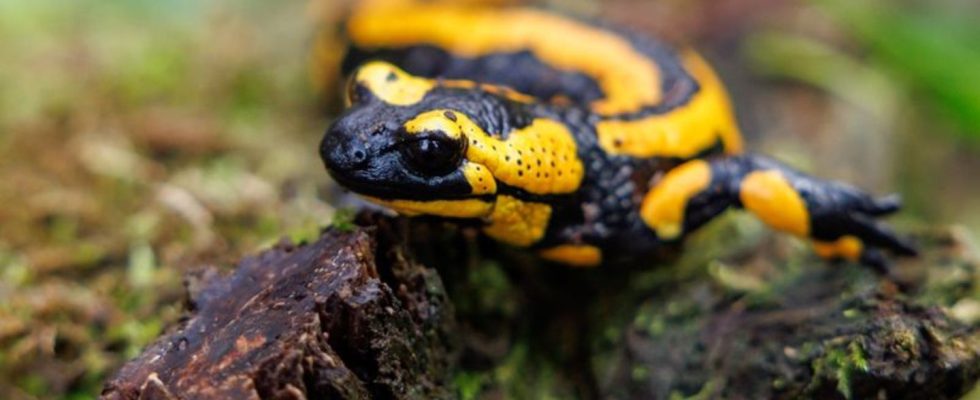The fire salamander is known to many as the comic character “Lurchi”. His adventures always have a happy ending. With the real fire salamander, however, things don’t look so good.
The fire salamander crawls leisurely through the moss. It is definitely not one of the fastest amphibians and immediately catches the eye with its black and yellow pattern. But he has nothing to fear here: the salamander lives in an enclosure in the Nuremberg Zoo. Some time ago he was still in great danger. He was infected with the skin fungus Bsal (Batrachochytrium salamandrivorans), also known as salamander eater fungus or salamander plague – and it is usually fatal.
But the fire salamander and four of its fellows were lucky. Conservationists found them in the Steigerwald in northern Bavaria and brought them to the Nuremberg Zoo. Veterinarian Hermann Will was able to heal her there. The infected amphibians spent two weeks in a warming cabinet – at a temperature of 25 degrees, which kills the fungus and which the fire salamanders can barely tolerate, as Will explains. “They survived the treatment well.”
Since then, the fire salamanders have lived in a small outdoor terrarium in the Nuremberg Zoo and will probably stay there. Putting them back in the Steigerwald is not possible, says Will. The recovered animals are not immune to a new infection. That’s why the zoo would like to use this to set up a conservation breeding program for the fire salamander. In Bavaria it is considered endangered, and throughout Germany it is on the warning list of the Red List of Threatened Species.
Children know the fire salamander (Salamandra salamandra) as the cartoon character “Lurchi,” who advertises a shoe brand. With its striking pattern – yellow spots on a black lacquer background – it is not only particularly pretty to look at, but also, with a length of up to 20 centimeters, it is the largest tailed amphibian in Germany. According to the German Society for Herpetology and Terrarium Science (DGHT), this makes it probably the best-known amphibian species in this country.
Multiple dangers
But most people have probably never seen it in nature. The fire salamander is predominantly nocturnal and feels most comfortable in natural mixed deciduous forests in the low mountain ranges with small spring streams and ponds in which it can place its larvae. But this living space is disappearing.
Climate change is also causing problems for fire salamanders. “The dryness is bothering them,” explains Malvina Hoppe from the nature conservation association LBV. “If small streams and ponds dry out before the larvae are developed, things become critical.” There is also the deadly skin fungus Bsal. In the Ruhr area, this led to mass extinctions, says biogeography professor Stefan Lötters from the University of Trier. He has been researching the salamander plague for a long time, but still sees many unanswered questions.
The skin fungus, which comes from Asia, probably came to Europe through the animal trade, says Lötters. It was first detected in the Netherlands in 2010, and later in Germany, Belgium and Spain. In Germany, the fungus occurs in the Ruhr area, in the Eifel, in the Steigerwald and in the Allgäu. In the Allgäu, where there are no fire salamanders, it attacks newts, but they do not die from it.
There is still a lot of research to be done
From Lötter’s point of view, it is still puzzling why there has not been a mass death in the Steigerwald as in the Ruhr area. “My guess is that there is another fungal variant there that is not as aggressive. But we don’t have any data on that.” It is also still unclear how long Bsal has actually been present in the affected regions. “We have evidence that he appeared near Aachen as early as 2004. But today he can no longer be found there.” Lötters concludes: “Somehow the fungus seems to be able to disappear again.” But how is still unknown.
In Lötters’ opinion, there is no danger of the fire salamander becoming extinct in Germany any time soon. “But we believe we are seeing a spread of Bsal.” He therefore believes it makes sense to contribute to species conservation through captive populations. “Until we know more about the fungus, how we can fight it or it dies out,” says Lötters.
Several stations for breeding
There is currently only space for a few fire salamanders in Nuremberg Zoo. A large outdoor enclosure is being planned. According to its own statements, the zoo in Wuppertal started a pilot project with the university and the Lower Nature Conservation Authority in the spring, for which fire salamanders and their larvae are taken from the wild, tested for Bsal and, after a quarantine period, brought to the breeding station.
Other zoos and private owners in Germany also take part in a conservation breeding program that is coordinated by the organization Citizen Conservation. This was founded by the DGHT, the Association of Zoological Gardens and the Frogs & Friends initiative. There are currently more than 150 fire salamanders in 16 postures, says project manager Johannes Penner. He believes it is important to act proactively. The actual threat posed by Bsal is not known. The last classification of the fire salamander on the Red List was from 2020, but the skin fungus was not taken into account.
However, there is also good news: “The fungus itself spreads very slowly,” says Lötters. “So there must be vectors.” For example, forest animals or people carrying the spores from one place to another. At least with the latter, we can start to prevent this: The Bavarian nature conservation association LBV calls on everyone to always stay on the paths in Bsal hotspots and to disinfect shoes, car and bicycle tires so as not to spread the spores.

